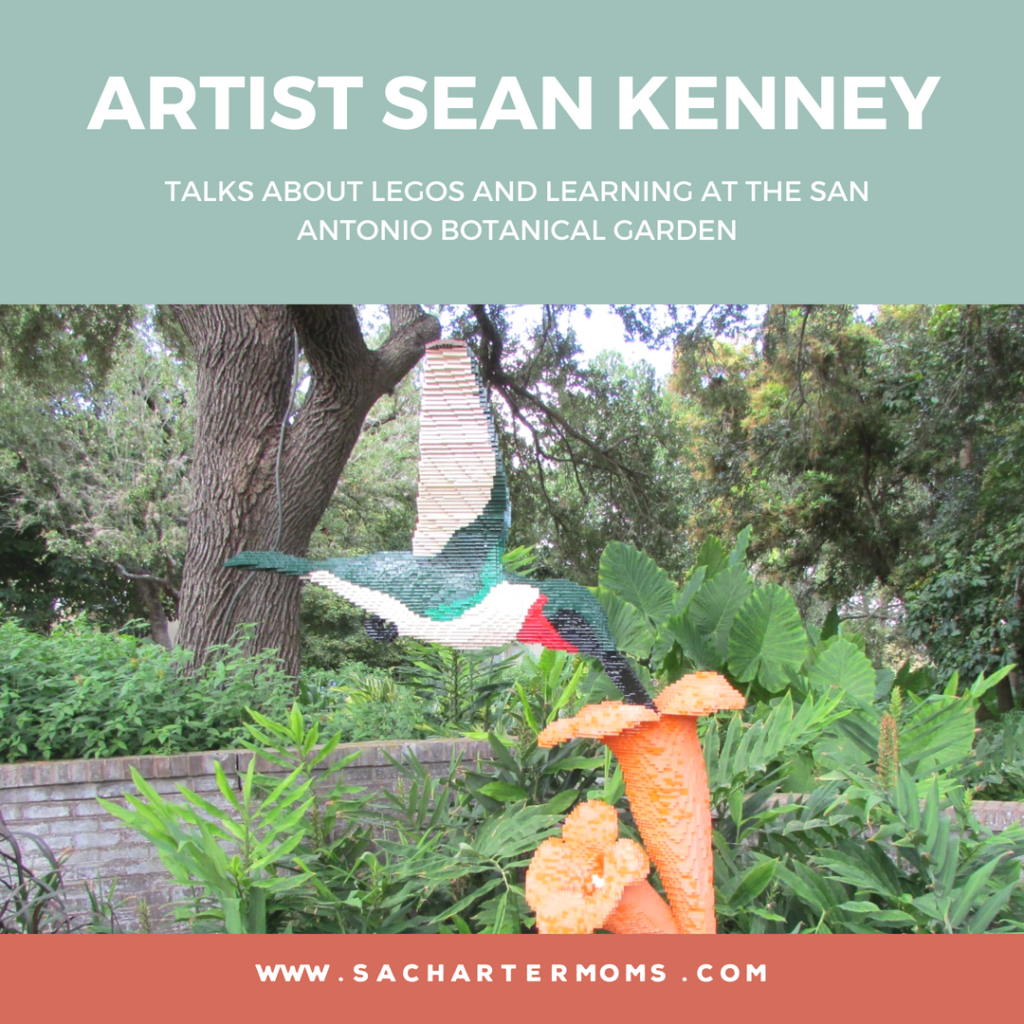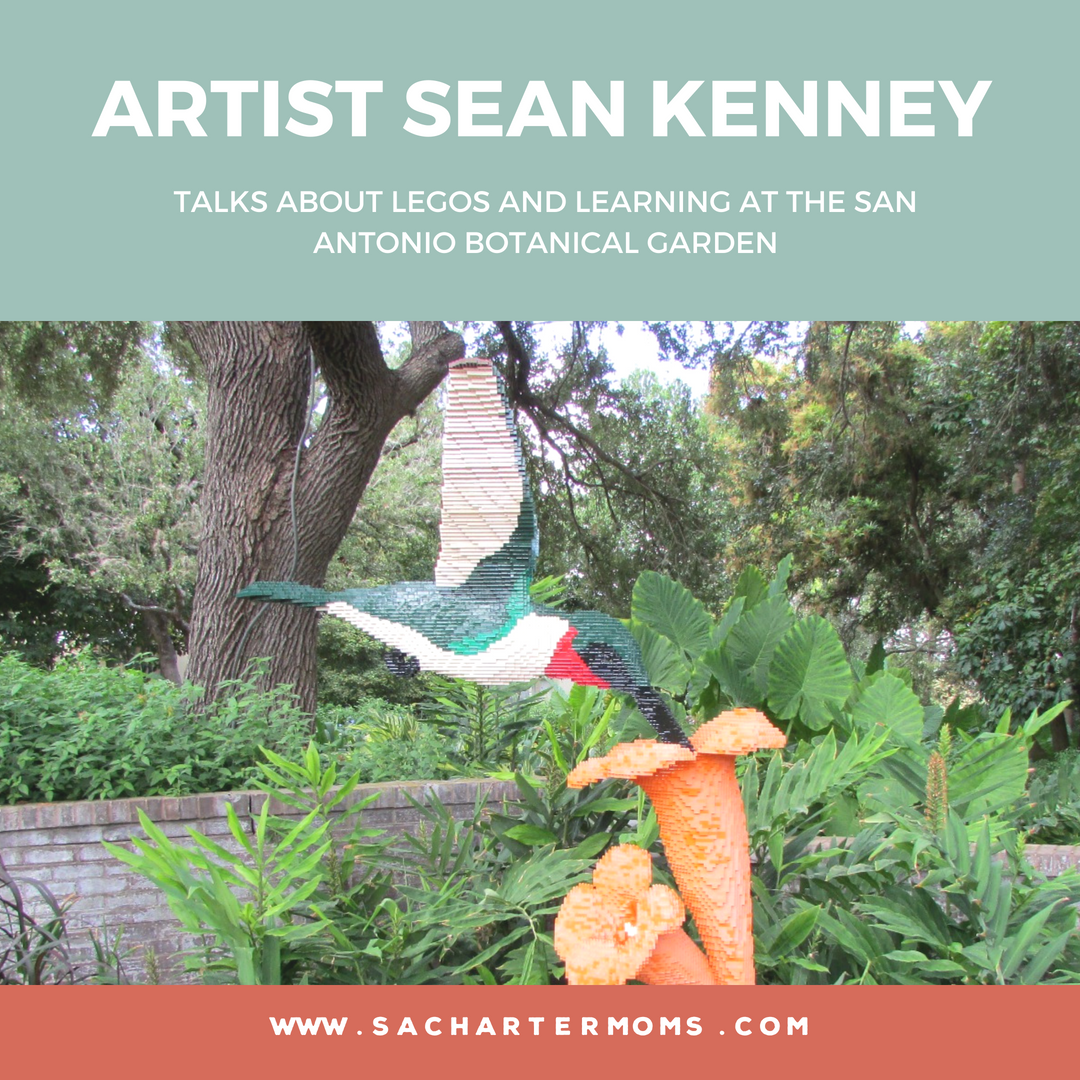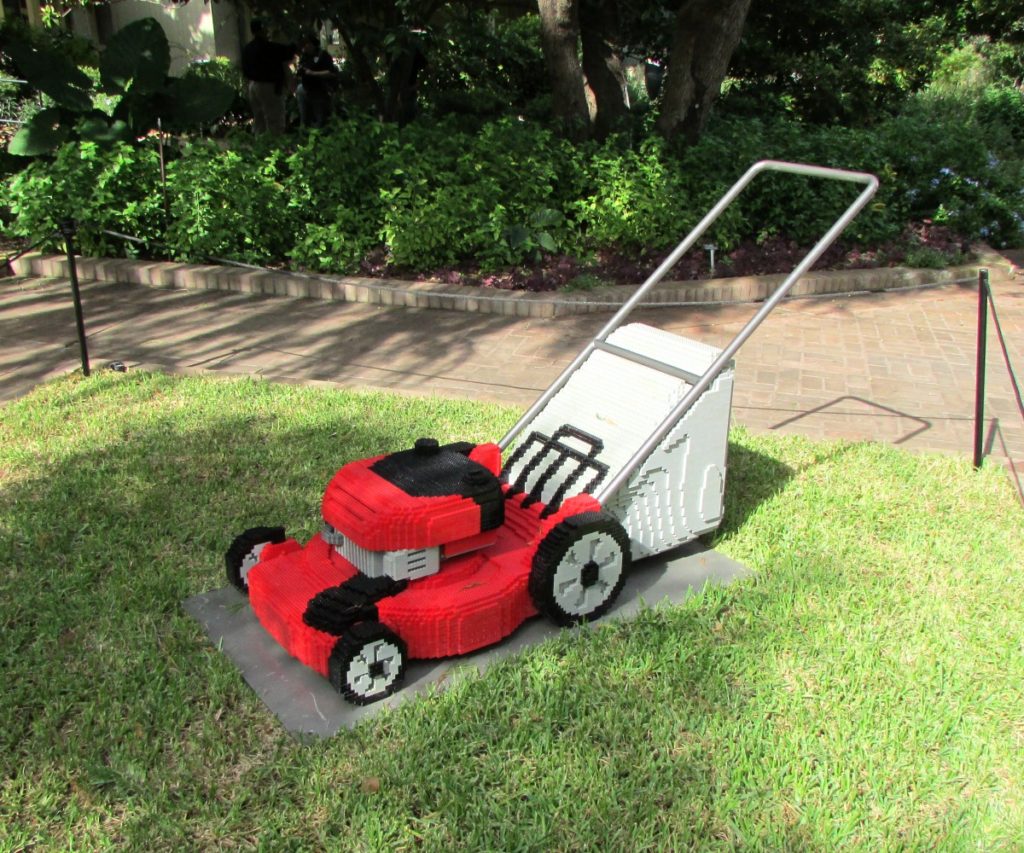
The San Antonio Botanical Garden is hosting Nature Connects: Art with LEGO® Bricks, an exhibit featuring giant LEGO sculptures, through January 4, 2015. My family and I attended the opening day events on September 6, and I got to talk with artist Sean Kenney about Nature Connects, his books, and all about LEGOs for fun and learning.
Kenney’s full-time job is designing and building LEGO sculptures. He and his wife have a new baby and a three-year-old daughter. “She’s probably the only three-year-old in the world who fully, 100 percent, comprehends her dad’s career,” he says. Kenney does not work for LEGO, but is a LEGO Certified Professional, which gives him a special role in sharing his love for LEGOs with kids and adults. The sculptures in Nature Connects are appropriate for the Botanical Garden because they feature wildlife and the ways humans interact with nature.
My questions for Kenney focused on how LEGOs help our kids to learn and grow. He “put his dad hat on” and shared some insights for families.
Do you have advice for parents when they bring their kids to see Nature Connects?
I hope that the kids can be inspired to do something themselves. With LEGO, you can do anything with it: you can draw, you can color, you can paint, you can build.
Kids don’t want to get dragged to the art museum. They have to come up with all kinds of programs to get kids to come in. Then, the kids still don’t want to look at a Renoir or a Picasso. And, even if they do, they’re not going to go home and break out the watercolors. They’re not going to look at a Rodin and then break out some play dough.
They see LEGO, and they immediately want to build stuff. To the point where they want to walk right up to it and take a piece off. They run right up to it because they want to see what it’s about.
Art is sort of a heavy word and we don’t even know how to read it and deal with it. I try to keep it lighthearted. It’s OK to laugh and have fun with it and be silly.
You can walk by that LEGO lawnmower and not have any idea that it’s not a real one unless you turn to look at it. People do a double take.
There’s a bird feeder that filled with LEGO pieces, and LEGO birds on the outside of it. Of course, LEGO birds have to eat LEGO pieces.
Each piece makes a statement about the connection with nature, the connection with man. The parent asks, “Do you know why the bird is eating out of the trumpet flower like that? They actually eat the juices that are inside the flower.” And now the kid is actually learning by accident.
What can parents do to support their kids’ learning with LEGO?
For me, it’s an exploratory thing. “Hey, what’s that? What can you do with that?”
[When my daughter was 5 months old, I went to LEGO headquarters and came back with a box of Duplos.] We propped her up. She grabbed one, she grabbed another, and put them in her mouth. [laughing] We’d stack pieces, and take them apart. We’d make a chicken and make chicken noises.
We noticed one day that she was kind of slamming them together. [Was she trying to make noise? Or was she trying to stick them together, but hadn’t discovered the bumps?]
At ten months old, she pushed two together, and pulled them apart, and pushed them together again. And I was so excited. And not as a LEGO guy, but just that I watched her learn how to do something, slowly, over a few months, that’s so simple and yet can be so complicated. By the time she was two years old, she was done with the Duplos and on to the regular LEGO sets.
She’s now 3. [After my wife had the baby, I stayed home for a while.] I was in withdrawal; my studio is across town. I wanted to play with my daughter so I bought a bunch of LEGO sets from the store. Trucks and cars and things. We dumped all the pieces out. She’s flipping through the book. “Hey, do you see any pieces that are in this step?” She rummages around, she finds one, she looks at it, and says, “Oops, that’s the wrong one.” She grabs another one, she looks at the picture, she figures out where it goes.
There’s so many things that are happening right there. The ability to see what’s different between the step and what you’re holding. The ability to find the piece in this large pile of other things. It’s the slope, but it’s the upside down version of the slope. Figuring out exactly where it goes in the model. The dexterity to be able to press them together. There’s a million little things going on.
Do you have tips for setting up a LEGO play space?
On my website you can see pictures of my studio. I keep all my pieces organized by size, by shape, by color. I have drawer units, like flat files, that have little cubby compartments of minifigure faces and hinges and coffee cup parts and grills and stuff.
But that’s because of the way I work as a grown-up as compared to a kid. Adults, we design first. We plan it out.
If you sit down with your kid, “Let’s make a house, I’ll do some stuff in the backyard. I’m gonna make a backyard grill, and make a swing. They make those little pieces they use on the front of the car, and I bet we could use that for the grill part.” And now you’re planning.
For kids, it’s more exploratory. They’re digging through the bin, looking for that grill piece, but they find something else, and suddenly they’re not making a house any more. Suddenly, it’s a moon unit, or whatever, and that’s OK, because that’s part of that creative process.
It’s not like, “Oh, that’s not how it’s supposed to go.” With my own daughter, I never say, “No,” when it comes to an idea. I say, “Hey, that’s neat. What are you thinking?”
[We were playing tic tac toe and] she put the O down on the X, on the same square. She said, “Look, see, now this is a special one, because this one can have two pieces, this is the two piece side.” She’s making stuff up as she goes. We’re playing Calvinball: every five seconds, the rules change.
Rectangles versus funky pieces?
[For years, people have been complaining that LEGO is not the way it used to be.] But when I was a kid, in the late 70s and early 80s, they had spaceships, and cars, and castles, and all that stuff, too. I wanted the Exxon gas station on my seventh birthday.
There’s a difference between a box of building blocks and the play sets. Buying a Lightning McQueen playset is better than just buying a Lightning McQueen already-made chunk of plastic toy. Later, when you get tired of Lightning McQueen, you can take it apart.
I personally think all the funky bits are fun. I like to turn them upside down, and left, and right, and make all kinds of different things.
I have millions of pieces in my studio, mostly all the rectangles, because I’m making these big sculptures.
For my books, I take all the funky bits. For my Cool Cars and Trucks book I went out and bought the fire station, the police car, the recycling truck, whatever, and I dumped all the parts out and jumbled them up, and I asked myself, “What can I make out of this?”
I wanted to try to different things with those parts than what they were intended. I take a trash can, and it’s just a cylinder. What can it be? It ended up sideways as the gas tank on a tractor trailer cab.
The bison’s eye is actually a radar dish, and a rim from the inside of a tire, where the radar dish happens to sit perfectly into it. The radar dish has a convex shape and so it reflects and gives a specular highlight on the eye. The wheel goes around it and makes it a little larger. And we angled it, because the head is not on the brick grid and so we angled it on a hinge—and then it’s all built in with the bricks around it. The idea is that you probably would never notice. And that’s kind of the point. If I did it wrong, you’d [notice]. And if we didn’t do it at all, and it was just blocky, it would look a little dead somehow. Like a mannequin.
Following the instruction sheet versus just going for it?
With the visual instruction sheet, there’s a lot that you’re learning there. At the same time, what you’re also learning, from the model-building technique perspective. The “how I got to where I am today” thing. There’s no university to learn how to build eight-foot LEGO hummingbirds. How did I learn? As a kid, I was following the directions. I was building the model as the designer had designed it. That designer is a guy who’s 35 years old and lives in Denmark and figured out how to make a gas station using the parts he had available, and now every other kid can do it. And that’s OK. You learn the techniques.
I remember following the directions and distinctly remembering that when you put the pieces up, they would always cross over at least more than one piece below. You never stack them straight up or you get seams. That’s the fundamental principle of how these things stay together.
Now that I’m playing again with my daughter, I know some of the designers now. I know Jamie designed this set because he put his initials on the license plate. I’ll think, hey, that’s kind of neat, they used this hinge piece, that originally came out on that other set, for a spaceship thing, and they turned it, and used it the other way, and now it lets the bin of the dump truck tip back. They use the same hinge for years and years in different ways.
I’m watching the designers figuring out new ways. Now that we have this little slope, we thought it would just be good for a headlight, but now we’re using it as the rear-view mirrors on the side of a car, and they’re turned up sideways, and they’re also the back end swooshy shape of a spaceship, or whatever.
Put it on the shelf, or take it apart and make something else?
When it gets to be a shame is when you build that set and then you put it on the shelf and let it get dusty. That is the antithesis of the point of the toy. I do meet a lot of parents who are like, “My son, he’s the best builder in the world, he follows all the instructions, he builds all the sets.” I ask, “Oh, what else does he like to make?” She says, “Oh, well he doesn’t want to take them apart because he loves them so much.” And I can understand that pride of creation. I can’t fault the kid for that, but he’s not taking that next step. There’s so much more that you can learn. Maybe you really liked that spaceship, but you really want that part on the inside for your robot. You take half the ship apart, and suddenly you’ve got all these new pieces, and they start making their way onto the robot. You’re taking that next step and creating from within, as opposed to the learning process of following those booklets.
Do you have advice for parents who worry that their kids are too obsessed with LEGOs?
[My advice is] everything is moderation. It’s like screen time: my daughter watches PBS Kids and then we have breakfast.
Going deep in something, that’s good. Depth of knowledge is incredibly important. We live in a society where we have a lawyer who doesn’t know the first thing about plumbing, and vice versa. And that’s actually good.
And that’s how kids learn. You throw a million things at them, ballet class, gymnastics, LEGO building, piano, Chinese lessons, not because you want to press all this onto them, but more like, “Oh, who knew that they were really going to take to singing.” And you want to take some lessons, that’s great, but don’t fall behind in math and reading.
Go deep down and figure that stuff out, be great at something.
Readers, I hope you will visit the San Antonio Botanical Garden this fall and tour Nature Connects. At the front desk, pick up a map and guide that will help you find all the sculptures through the garden; answer the questions on the back and turn in the guide for a prize at the Garden Gate Gift Shop. Consider becoming a member so you can visit again and again; a one-year family membership costs $65. Members get a discount at the gift shop (which has Kenney’s books in stock) and on parties, including special LEGO-themed birthday parties on weekends through January 4. For information or to schedule a party, email the Education department at education [at] sabot [dot] org.
Read more:
- “Free ways to entertain your LEGO-obsessed kids before The LEGO Movie comes out on Feb. 7”, Colleen Pence, San Antonio Mom Blogs, December 19, 2013 (reviewing Kenney’s book Cool Creations in 35 Pieces, plus more LEGO activity tips)
- “LEGO sculptures capture generations”, Josh Baugh, San Antonio Express-News, September 6, 2014
- “Birdhouses built for kid-sized fun at the San Antonio Botanical Garden”, Inga Cotton, Alamo City Moms Blog, May 9, 2014 (past exhibit at the Botanical Garden)
- “[Gallery] Scarecrow Trail at the San Antonio Botanical Garden”, Inga Cotton, San Antonio Charter Moms, October 14, 2013 (last year’s scarecrows; look for a repeat starting September 22, 2014)
- “[Gallery] BOOtanica! Fall Festival at the San Antonio Botanical Garden”, Inga Cotton, San Antonio Charter Moms, October 26, 2013 (save the date for October 25, 2014)
- “[Gallery] Holidays in Bloom at the San Antonio Botanical Garden”, Inga Cotton, San Antonio Charter Moms, December 10, 2013 (last year’s holiday decorations at the Botanical Garden; coming back again this year, starting November 28, 2014)
- “Introducing your kids to art appreciation at the McNay Art Museum”, Inga Cotton, Alamo City Moms Blog, January 30, 2014 (my kids actually do like art museums)






